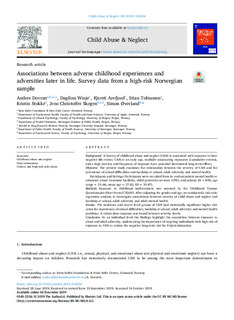| dc.contributor.author | Dovran, Anders | |
| dc.contributor.author | Winje, Dagfinn | |
| dc.contributor.author | Arefjord, Kjersti Jorunn | |
| dc.contributor.author | Tobiassen, Stian | |
| dc.contributor.author | Stokke, Kristin | |
| dc.contributor.author | Skogen, Jens Christoffer | |
| dc.contributor.author | Øverland, Simon Nygaard | |
| dc.date.accessioned | 2020-02-05T08:48:50Z | |
| dc.date.available | 2020-02-05T08:48:50Z | |
| dc.date.created | 2019-11-21T12:03:20Z | |
| dc.date.issued | 2019-11 | |
| dc.identifier.citation | Dovran, A., Winje, D., Arefjord, K.J. (et al.) Associations between adverse childhood experiences and adversities later in life. Survey data from a high-risk Norwegian sample. International Journal of Child Abuse & Neglect, 98. | nb_NO |
| dc.identifier.issn | 0145-2134 | |
| dc.identifier.uri | http://hdl.handle.net/11250/2639697 | |
| dc.description.abstract | Background: A history of childhood abuse and neglect (CAN) is associated with exposure to later negative life events. CAN at an early age, multiple cooccurring exposures (cumulative events), and a high severity and frequency of exposure have potential detrimental long-term effects.
Objective: The present study examines the relationship between the severity of CAN and the prevalence of school difficulties and hardship at school, adult adversity and mental health.
Participants and Settings: Participants were recruited from in- and out patient mental health or substance abuse treatment facilities, child protective services (CPS),and prisons (N=809, age range = 13–66, mean age= 27.62,SD=10.47).
Methods: Exposure to childhood maltreatment was assessed by the Childhood Trauma Questionnaire Short Form (CTQ-SF). After adjusting for gender and age, we conducted a risk ratio regression analysis to investigate associations between severity of child abuse and neglect and hardship at school, adult adversity and adult mental health.
Results: The moderate and severe level groups of CAN had statistically significant higher risk ratios for experiences of school difficulties, hardship at school, adult adversity and mental health problems. A robust dose-response was found between severity levels.
Conclusion: At an individual level the findings highlight the association between exposure to abuse and adult adversity, underscoring the importance of targeting individuals with high risk of exposure to CAN to reduce the negative long-term risk for Polyvictimization. | nb_NO |
| dc.language.iso | eng | nb_NO |
| dc.publisher | Elsevier Ltd. | nb_NO |
| dc.rights | Attribution-NonCommercial-NoDerivatives 4.0 Internasjonal | * |
| dc.rights.uri | http://creativecommons.org/licenses/by-nc-nd/4.0/deed.no | * |
| dc.subject | barnemishandling | nb_NO |
| dc.title | Associations between adverse childhood experiences and adversities later in life. Survey data from a high-risk Norwegian sample | nb_NO |
| dc.type | Journal article | nb_NO |
| dc.type | Peer reviewed | nb_NO |
| dc.description.version | publishedVersion | nb_NO |
| dc.rights.holder | © 2019 The Author(s). | nb_NO |
| dc.subject.nsi | VDP::Social science: 200::Social work: 360 | nb_NO |
| dc.source.pagenumber | 1-8 | nb_NO |
| dc.source.volume | 98 | nb_NO |
| dc.source.journal | International Journal of Child Abuse & Neglect | nb_NO |
| dc.identifier.doi | 10.1016/j.chiabu.2019.104234 | |
| dc.identifier.cristin | 1750429 | |
| cristin.unitcode | 217,7,0,0 | |
| cristin.unitname | Det samfunnsvitenskapelige fakultet | |
| cristin.ispublished | true | |
| cristin.fulltext | original | |
| cristin.qualitycode | 1 | |

